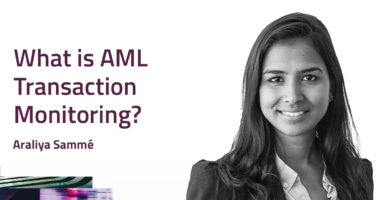The financial industry made a good choice when they dubbed upstart, digitally native banks ‘challenger banks’. Those banks have presented numerous healthy challenges to established financial institutions and their incumbent methods for doing things.
Fighting financial crime is an excellent example of this. Challenger banks and neobanks tend to start with small, nimble teams that are responsible for fraud management and anti-money laundering. Those teams have to rely on their technology, and the efficiencies that technology creates, to detect and prevent financial crimes at the level established banks can. Often, the fraud and AML teams have to work together — using the same platform, using the same data — for the sake of efficiency. That saves the bank money and spreads the crime-fighting capacities between both teams. Today, we call that FRAML.
For generations, banks fought fraud and money laundering with different teams and different tools. Challenger banks helped challenge the assumption that those activities should be siloed. What we are learning now is that both fraud and AML teams share overlapping goals, and both benefit when they share their data and perspectives.
FRAML provides a strategy for those two teams to work as one. The upside for the bank:
- Increased information and insight sharing.
- Faster investigations.
- Better transaction monitoring.
The key to unlocking these upsides, however, is to tailor your own FRAML strategy to the specific needs of your business. Below are five questions to ask yourself when you start to develop that strategy.
1. Am I making my analysts’ lives easier or harder?
Currently, one of the methods most used in money laundering is through the recruitment of money mules. In this tactic, unsuspecting people are solicited with opportunities to make quick and easy money on the side. The execution is usually nothing more than a simple set of instructions to that person to move money from point A to point B, or by gaining direct access to the account. Criminals put tremendous effort into legitimizing the opportunity to sell people on opting in.
For the analyst tracking a case of suspected activity, there’s a separate challenge: When do you intervene? Sometimes, the answer is “right now!” so the bank can block a transaction, report a fraudster and protect a customer. Sometimes, the answer is “not quite yet” because there is potential to investigate the case further. There’s a window of opportunity to get the action right.
That call is easier to make when the fraud and AML teams share a system. A single analyst unit, covering both fraud and AML and working with a common behavioral analytics platform, will enable data points, models, and adaptive rules to be shared across the team. Behavioral analytics are key because this approach triages alerts according to an ever-evolving risk profile, allowing analysts to always focus on the most suspicious alerts first (and something for which they’ll thank you).
2. Are we monitoring more than transactions?
Another way to ask this question: “What else could we be looking for?”
Fraud and money laundering are very often intrinsically linked. Take fraud cases for example. The data points analyzed by fraud teams offer analysts investigating AML an opportunity to take a potentially wider view, if AML rules incorporate detection logic based on data that has traditionally been used in fraud alerts. In addition to near-real-time transactional data, there’s also the in-session data, the unique device ID, the IP address, location, and a number of other non-monetary events in play, as well.
The fraud team might discover a suspicious login coupled with another behavioral anomaly, which could be the earliest opportunity for a converged team to identify a wider pattern of laundering illicit funds.
For the converged team, this means:
- A wider data view and use of fraud data points for AML, which will be useful and are probably currently underused.
- Ease of handover and escalation between fraud and AML teams. A shared solution helps to remove any duplication of investigative time.
A shared behavioral analytics platform will surface and prioritize cases according to the risk profile more accurately. Ultimately, this makes risk teams more effective, and ensures effort is spent investigating quantified suspicious activity.
3. Does our FRAML team have the right roster?
Innovation isn’t always about code. Sometimes, it can come down to decisions about organizational structure.
Take IT as an example. Some challenger banks made an early decision to equip their FRAML team with dedicated technical teams. The tech team sits within the wider team, which has proved to be a highly effective approach.
Established banks benefit from re-converging their fraud and AML teams too because the dedicated engineers can manage issues more effectively and efficiently when they’re closer to the technical challenges both teams face.
Further, fraud detection and prevention are considered a revenue generator. AML is a cost center. As a result, businesses can be wary of committing new, costly resources to AML teams. However, the regulatory scrutiny in AML is sufficient to drive the need for this investment. When the teams converge, AML often gets access to better tools, and the business overall enjoys a more holistic risk management strategy.
4. Are we investing in the success of our FRAML team?
Bringing together separate — and differently experienced — teams and asking them to work together can sometimes be like gathering two people who speak different languages and asking them to read a map.
They have a rough idea of what’s going on, but the crucial details can’t be easily shared.
Similarly, getting your fraud and AML analysts to communicate effectively is crucial. Like a common language, shared systems go a long way, but a lot more can be achieved with quality training.
The aim should be to give fraud specialists a firm grounding, beyond the company’s standard training in money laundering and fraud. That training can be a big upfront investment, but it pays dividends in resource management over the long term.
Challenger banks provide analysts with experience in both fraud and AML by structuring a smaller team of dual-skilled analysts that can work together interchangeably in one place. Scams suddenly on the rise? No problem. Your team can pivot and work on those alerts right now.
Contrast that kind of agility with the bigger — and sometimes geographically separate — teams in more traditional banks.
5. Where are the information barriers?
Even if they are capable and experienced, analysts are unlikely to switch between fraud and AML in a single working session. The pressures of each discipline require a singular focus.
But having cross-skilled team members who understand the importance of when and where to share insights, tools, and strategies? That is critical to building a successful FRAML team.
The need for dedicated fraud and AML experts isn’t going away any time soon. Nonetheless, a converged FRAML team will identify more patterns, make more informed decisions, and fight financial crime more efficiently.
Building that team requires a well-thought-out strategy. Start by challenging silos within the business. From there, adopt a common technology solution and foster a collaborative culture among your fraud and AML teams. This will lay the groundwork for the efficiencies and effective crime-fighting capabilities FRAML offers.
To find out how you can develop and implement a successful FRAML approach, download our step-by-step FRAML guide.
Share

 by
by 



